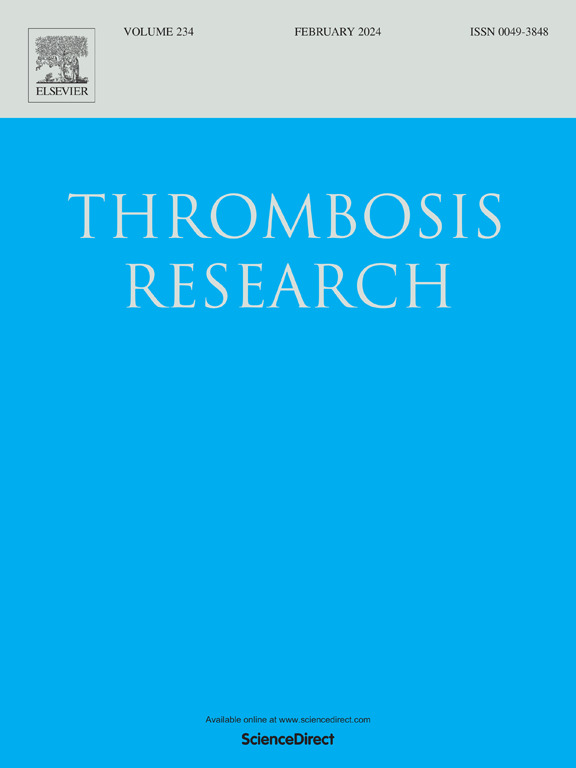Genetic determinants of activated factor VII-antithrombin plasma levels and mortality in patients with coronary artery disease
IF 3.4
3区 医学
Q1 HEMATOLOGY
引用次数: 0
Abstract
Background
Activated factor VII-antithrombin complex (FVIIa-AT) is an indirect plasma biomarker of the interaction between tissue factor (TF) and FVIIa. High FVIIa-AT levels have been associated with an increased risk of mortality.
Methods
We investigated the genetic determinants of FVIIa-AT plasma levels by a candidate gene approach in a cohort of 610 subjects with (n = 478) or without (n = 132) angiographically-demonstrated coronary artery disease (CAD).
Results
Plasma concentration of FVIIa-AT did not differ between CAD and CAD-free subjects, but predicted the mortality risk in CAD during a median follow-up of 64-months. Among 7 polymorphisms in 4 candidate genes, codifying for FVII, TF, Endothelial Protein C Receptor (EPCR), and Low-density lipoprotein receptor-Related Protein 1 (LRP1), none was associated with CAD. Three of them were independently associated with FVIIa-AT plasma concentration. F3 -603 A > G polymorphism predicted mortality in CAD consistent with the influence on FVIIa-AT levels, with the G allele-carriers having both higher FVIIa-AT concentration (86.4 with 95 %CI 82.4–90.5 versus 76.7 with 95 %CI 71.0–82.8 pM) and higher mortality risk (HR 1.92 with 95 %CI 1.08–3.41) as compared with AA homozygotes. Conversely, the F7 -323 A1/A2, the strongest genetic predictor of FVIIa-AT variability, and EPCR Ser219Gly polymorphisms were associated with FVIIa-AT levels but were not predictive of mortality.
Conclusions
Our results indicate that FVIIa-AT plasma levels are influenced by distinct genetic determinants linked to either TF or FVII expression. The heterogeneous association of FVIIa-AT-related polymorphisms with mortality risk in CAD suggests a predominant role of TF expression rather than FVII levels in the setting of secondary cardiovascular prevention.

冠心病患者活化因子-抗凝血酶血浆水平和死亡率的遗传决定因素
活化因子7 -抗凝血酶复合物(FVIIa- at)是组织因子(TF)与FVIIa相互作用的间接血浆生物标志物。高fvia - at水平与死亡风险增加有关。方法采用候选基因方法,对610例(n = 478)或未(n = 132)冠脉造影显示冠心病(CAD)的受试者进行了FVIIa-AT血浆水平的遗传决定因素研究。结果血浆FVIIa-AT浓度在冠心病患者和非冠心病患者之间无差异,但可预测冠心病患者在中位随访64个月期间的死亡风险。在编码FVII、TF、内皮蛋白C受体(EPCR)和低密度脂蛋白受体相关蛋白1 (LRP1)的4个候选基因的7个多态性中,没有一个与CAD相关。其中3种与FVIIa-AT血浆浓度独立相关。F3 -603 A >; G多态性预测CAD的死亡率与FVIIa-AT水平的影响一致,与AA纯合子相比,G等位基因携带者具有更高的FVIIa-AT浓度(86.4 pM, 95% CI 82.4-90.5 vs 76.7 pM, 95% CI 71.0-82.8 pM)和更高的死亡风险(HR 1.92, 95% CI 1.08-3.41)。相反,F7 -323 A1/A2 (FVIIa-AT变异性的最强遗传预测因子)和EPCR Ser219Gly多态性与FVIIa-AT水平相关,但不能预测死亡率。结论FVIIa-AT血浆水平受到与TF或FVII表达相关的不同遗传决定因素的影响。fviia - at相关多态性与冠心病死亡风险的异质性关联表明,在心血管二级预防中,TF表达比FVII水平起主导作用。
本文章由计算机程序翻译,如有差异,请以英文原文为准。
求助全文
约1分钟内获得全文
求助全文
来源期刊

Thrombosis research
医学-外周血管病
CiteScore
14.60
自引率
4.00%
发文量
364
审稿时长
31 days
期刊介绍:
Thrombosis Research is an international journal dedicated to the swift dissemination of new information on thrombosis, hemostasis, and vascular biology, aimed at advancing both science and clinical care. The journal publishes peer-reviewed original research, reviews, editorials, opinions, and critiques, covering both basic and clinical studies. Priority is given to research that promises novel approaches in the diagnosis, therapy, prognosis, and prevention of thrombotic and hemorrhagic diseases.
 求助内容:
求助内容: 应助结果提醒方式:
应助结果提醒方式:


